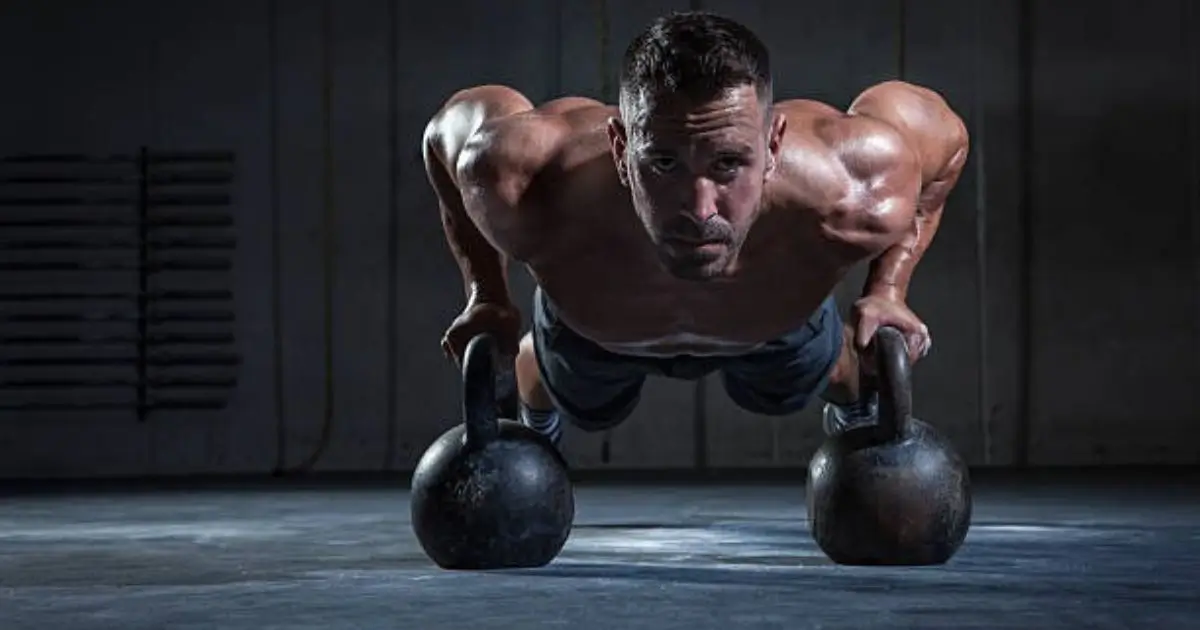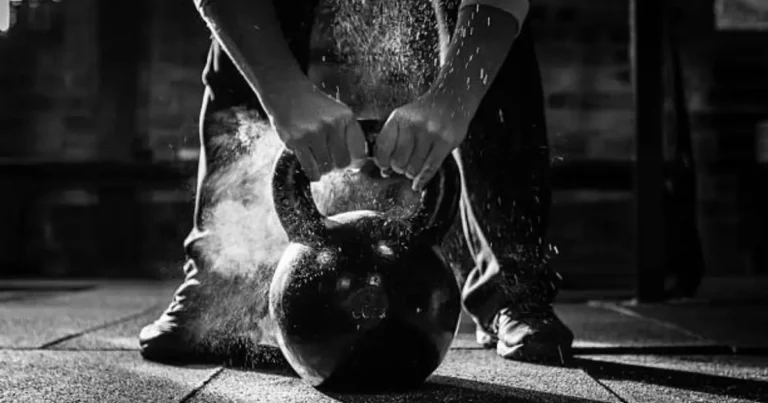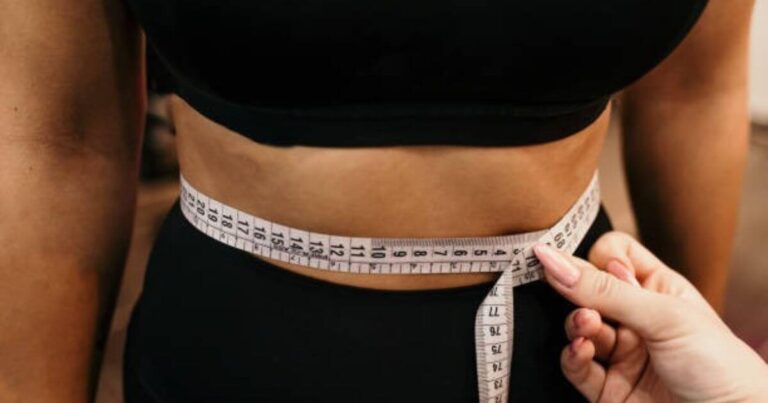The Ultimate Kettlebell Shoulder Workout: Build Strength, Stability & Size
Are you looking to develop powerful, resilient shoulders that look impressive and perform even better? A well-designed kettlebell shoulder workout might be exactly what you need. Kettlebells offer unique training advantages that traditional dumbbells and barbells simply can’t match, making them particularly effective for comprehensive shoulder development.
In this guide, you’ll discover the most effective kettlebell shoulder exercises, learn proper form techniques to protect your joints, and access complete workout routines tailored to your experience level. Whether you’re training at home with minimal equipment or adding variety to your gym routine, these kettlebell shoulder workout strategies will help you build stronger, more stable, and better-looking shoulders.
Table of Contents
Why Kettlebells are Phenomenal for Shoulder Development
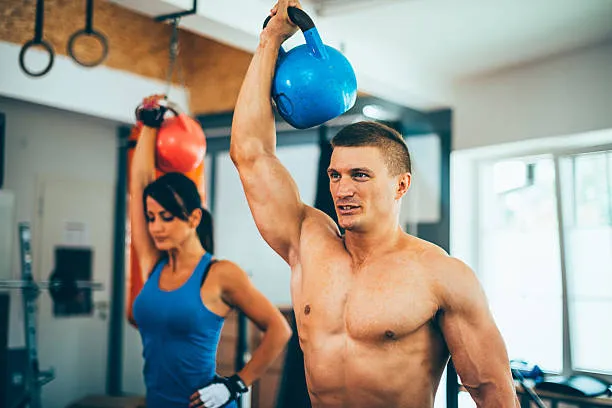
Traditional shoulder training often relies heavily on barbells and dumbbells, but kettlebells offer distinct advantages that make them particularly valuable for shoulder development:
- Enhanced Stabilizer Activation – The offset weight distribution forces your rotator cuff and other stabilizing muscles to work overtime, building resilience and reducing injury risk
- Improved Proprioception and Joint Stability – The unbalanced nature of kettlebell movements enhances your shoulder’s positional awareness and control
- Unique Movement Patterns – Exercises like halos and bottoms-up presses aren’t possible with traditional equipment, creating novel stimulus for growth and mobility
- Grip Strength Integration – Every kettlebell shoulder exercise simultaneously builds crucial grip strength, which directly supports heavier overhead lifting
- Functional Strength Carryover – The instability of kettlebell training translates exceptionally well to real-world movements and sports performance
While barbells allow for maximal loading and dumbbells offer balanced resistance, kettlebells combine the best of both worlds while adding rotational challenges that develop shoulders in three dimensions. The ideal approach often incorporates multiple tools, but a kettlebell-only shoulder routine can absolutely deliver outstanding results.
Critical Safety & Form for Kettlebell Shoulder Training: Protecting Your Joints
The shoulder is an inherently unstable joint with tremendous mobility, making proper technique non-negotiable. Master these fundamentals before progressing to heavier weights:
Shoulder Packing
Before any overhead kettlebell movement:
- Pull your shoulders down away from your ears
- Slightly draw your shoulder blades back and down
- Maintain this “packed” position throughout the exercise
- Never allow shoulders to elevate or roll forward during overhead movements
Proper Rack Position
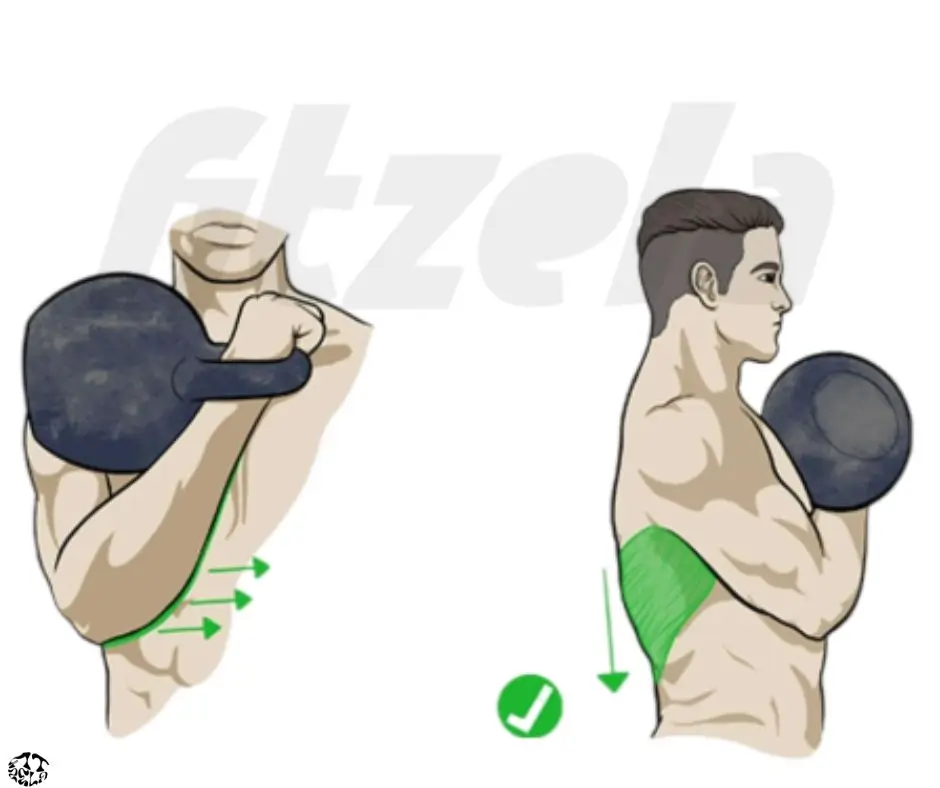
The foundation of many kettlebell shoulder exercises:
- Hold the kettlebell close to your body at shoulder height
- Position the bell outside your forearm, not behind it
- Keep your wrist straight, not bent backward
- Elbow should be close to your torso, not flared out
- Engage your lats to create a stable shelf for the kettlebell
Core Bracing
- Take a breath in and brace your core as if preparing for a punch
- Keep your ribcage down (avoid excessive arching)
- Maintain total-body tension during overhead movements
- Never compromise spine position for additional range of motion
Avoiding Shoulder Impingement
- Keep elbows tracking at approximately 45° from your body during presses, not directly out to sides
- Follow natural arcing motion patterns rather than strict vertical or horizontal paths
- If you feel pinching in the front of the shoulder, adjust your movement pattern or range
“Your shoulders need stability before mobility, and control before load. Master the foundations and the strength will follow.” – Pavel Tsatsouline
The Best Kettlebell Exercises for Comprehensive Shoulder Development
Kettlebell Strict Press
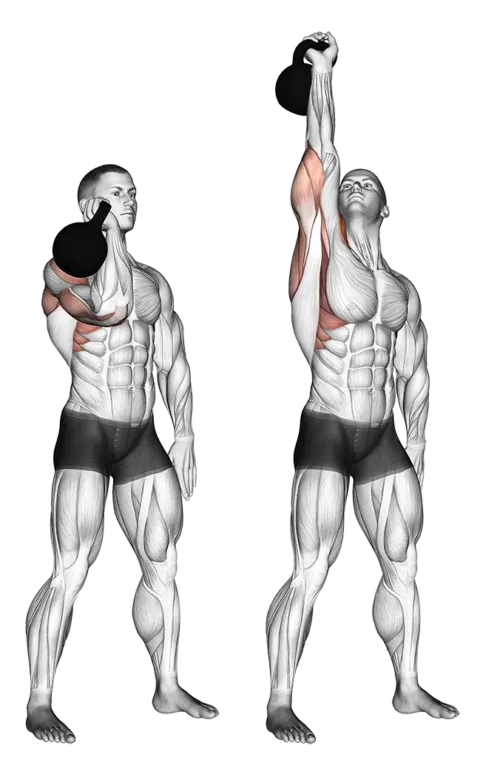
Target muscles: Anterior deltoids, medial deltoids, triceps, upper traps, serratus anterior
Step-by-Step Instructions:
- Begin in the rack position with the kettlebell at shoulder height
- Brace your core and pack your shoulder
- Press the kettlebell straight overhead without using leg drive
- At the top, your bicep should be close to your ear
- Lower the weight with control back to the rack position
- Repeat for the prescribed repetitions before switching sides
Pro Tips:
- Keep your elbow path slightly forward, not directly out to the side
- Create tension by “pulling” the kettlebell handle apart (even though it won’t move)
- Focus on a vertical pressing path without excessive arching
Variations:
- Double kettlebell strict press (using two kettlebells)
- Seated strict press (eliminating lower body assistance)
- Half-kneeling press (challenging core stability)
Kettlebell Push Press
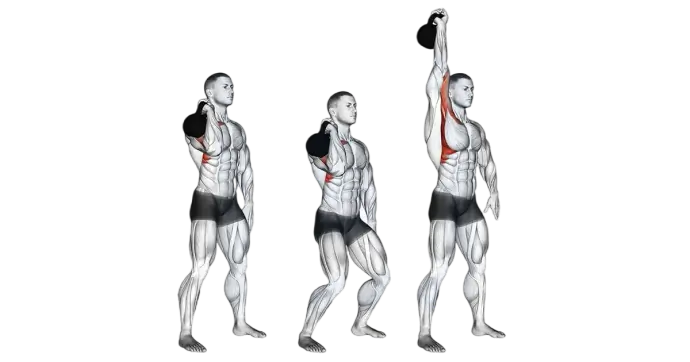
Target muscles: Anterior deltoids, medial deltoids, triceps, traps, legs (for drive)
Step-by-Step Instructions:
- Start in the rack position
- Initiate a quarter squat by bending knees slightly
- Explosively drive through your legs while pressing the kettlebell overhead
- Finish with the kettlebell locked out overhead
- Lower the weight with control back to rack position
Pro Tips:
- The leg drive should initiate the movement, with arms completing the press
- Keep torso upright during the dip phase
- Time the transition from leg drive to arm press for maximum efficiency
Variations:
- Double kettlebell push press
- Thruster (combining full squat with overhead press)
Kettlebell Bottoms-Up Press
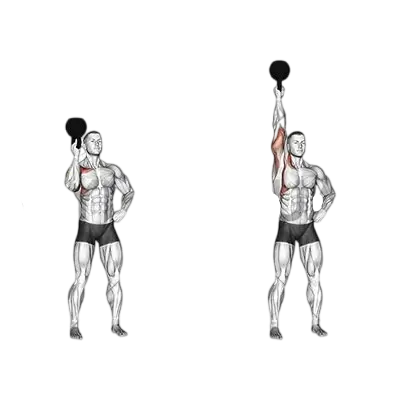
Target muscles: Deltoids, rotator cuff stabilizers, forearm grip muscles
Step-by-Step Instructions:
- Hold the kettlebell by the handle with the bell pointing upward
- Start in a rack position with the upside-down kettlebell at shoulder height
- Brace your core and stabilize the wobbling kettlebell
- Press the kettlebell overhead while keeping it balanced
- Slowly return to the starting position with control
Pro Tips:
- This is primarily a stability exercise—use a lighter weight than normal
- Focus on keeping the kettlebell perfectly vertical throughout
- Crushing grip is essential—squeeze the handle hard
Variations:
- Bottoms-up clean to press
- Bottoms-up walk (carrying the kettlebell in the upside-down position)
Kettlebell Halo
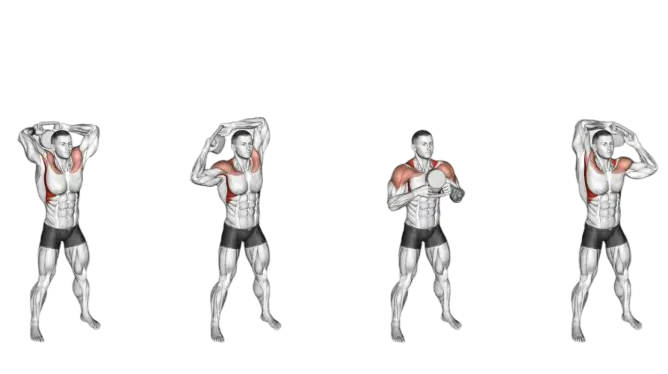
Target muscles: Deltoid complex, rotator cuff, upper traps, rhomboids
Step-by-Step Instructions:
- Hold a kettlebell by the horns (sides of the handle) at chest height
- Keeping elbows bent, circle the kettlebell around your head in a “halo” motion
- Keep the kettlebell as close to your head as possible without touching
- Complete prescribed repetitions in one direction, then reverse
Pro Tips:
- Move slowly and deliberately—this is not a speed exercise
- Maintain an upright posture throughout
- The motion should be fluid, not jerky or segmented
Variations:
- Kneeling halos (eliminating lower body compensation)
- Figure-8 halos (alternating forward and backward directions)
Turkish Get-Up (Shoulder Component)
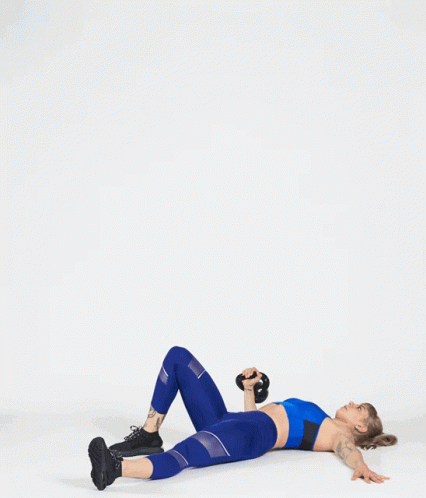
Target muscles: Entire shoulder complex, particularly stabilizers
Step-by-Step Instructions:
- Lie on your back with the kettlebell pressed up in one hand, arm vertical
- Keep your eyes on the kettlebell throughout the movement
- Roll to your elbow, then to your hand
- Sweep your leg through to a half-kneeling position
- Stand up while keeping the kettlebell overhead
- Reverse the movement to return to the starting position
Pro Tips:
- The Turkish Get-Up is complex—master each phase individually before combining
- The shoulder stability required makes this an excellent rotator cuff developer
- Focus on keeping the arm vertical throughout—don’t let it drift
Variations:
- Bottom-half TGU (floor to tall sit position)
- Top-half TGU (tall sit to standing)
Kettlebell Windmill
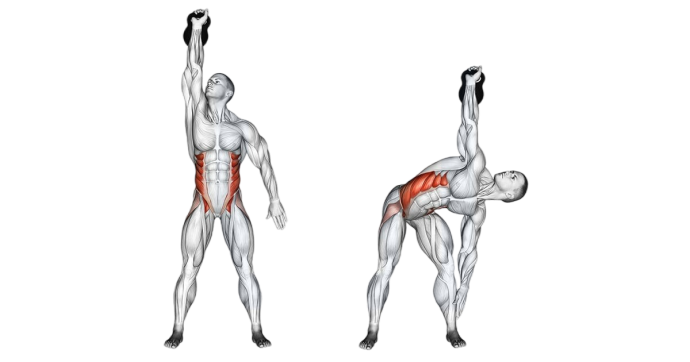
Target muscles: Posterior deltoids, lats, obliques, hip complex
Step-by-Step Instructions:
- Press the kettlebell overhead and lock your arm
- Turn your feet approximately 45° away from the arm holding the kettlebell
- Keeping your eyes on the kettlebell, hinge at the hips
- Reach your free hand toward your opposite foot
- Maintain a straight line from the kettlebell to your planted foot
- Return to the upright position by engaging your obliques and lats
Pro Tips:
- This is primarily a mobility and stability exercise—start light
- Keep the overhead arm locked throughout the movement
- Your weight should shift to the foot on the same side as the kettlebell
Variations:
- Bottoms-up windmill (extreme stability challenge)
- Two-kettlebell windmill (one overhead, one in the lowered hand)
Designing Your Kettlebell Shoulder Workout Plan
Selecting Appropriate Kettlebell Weights
| Experience Level | Men (Pressing) | Women (Pressing) | For Stability Exercises |
| Beginner | 12-16kg | 8-12kg | 25-50% lighter |
| Intermediate | 20-24kg | 12-16kg | 25-50% lighter |
| Advanced | 28-32kg+ | 16-24kg+ | 25-50% lighter |
Remember: It’s better to master proper form with a lighter kettlebell than to struggle with improper form using a heavier one.
Sets, Reps, and Rest Guidelines
| Training Goal | Sets | Reps | Rest Period | Tempo |
| Strength | 3-5 | 3-5 | 2-3 min | Controlled, deliberate |
| Hypertrophy | 3-4 | 6-12 | 60-90 sec | Moderate |
| Endurance | 2-3 | 12-20 | 30-60 sec | Continuous |
| Stability | 2-3 | 5-8 | 90 sec | Slow, focused |
Frequency
- Beginners: Direct shoulder training 1-2× weekly with at least 48 hours recovery
- Intermediate: 2× weekly direct training with varied intensity/volume
- Advanced: Up to 3× weekly with proper programming and recovery protocols
Always prioritize recovery—shoulders are particularly prone to overtraining injuries.
Sample Kettlebell Shoulder Workout Routines
Beginner Kettlebell Shoulder Routine
Focus: Mastering fundamentals and building baseline strength
Equipment: 1-2 kettlebells

- KB Halo – 2 sets of 5 reps each direction
- Single-Arm KB Strict Press – 3 sets of 5-8 reps each arm
- KB Rack Carry – 3 sets of 30 seconds each arm
- KB Farmer’s Carry – 2 sets of 45-60 seconds
Rest 90 seconds between sets. Complete this workout twice weekly.
Intermediate Strength & Size Routine
Focus: Building shoulder mass and strength
Equipment: 2+ kettlebells of varying weights

- Single-Arm KB Push Press – 4 sets of 6-8 reps each arm
- Alternating KB Clean & Press – 3 sets of 8 reps total
- KB Halo to Press – 3 sets of 6 reps
- KB Windmill – 2 sets of 5 reps each side
- KB Overhead Carry – 2 sets of 30 seconds each arm
Rest 60-75 seconds between sets. Perform 2× weekly.
Advanced Shoulder Stability & Resilience Routine
Focus: Maximum shoulder development and bulletproofing
Equipment: Multiple kettlebells
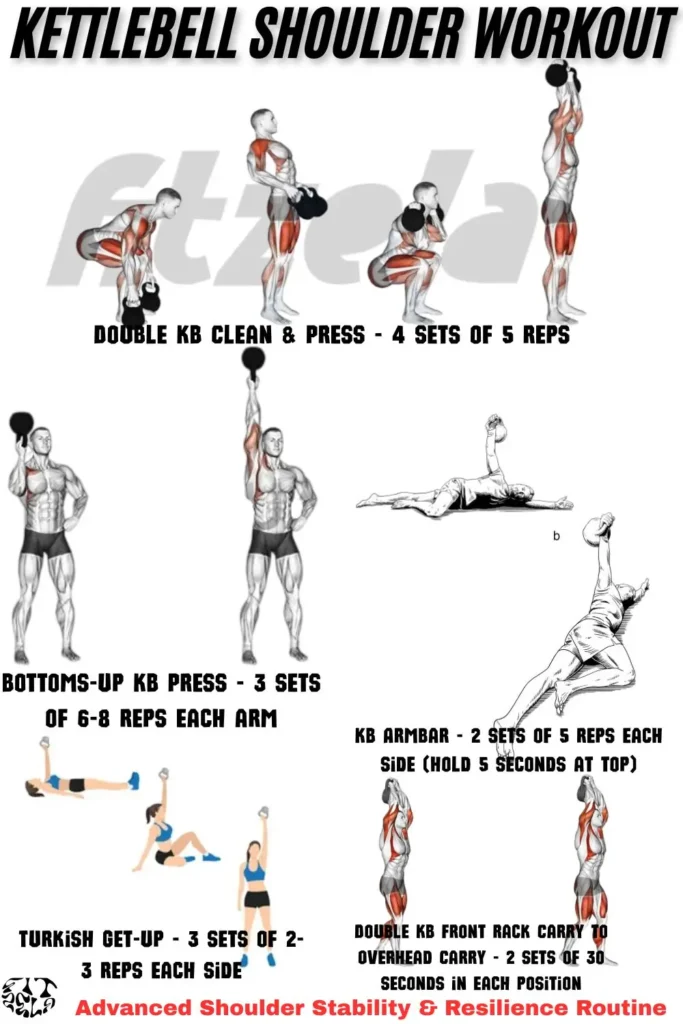
- Double KB Clean & Press – 4 sets of 5 reps
- Bottoms-Up KB Press – 3 sets of 6-8 reps each arm
- KB Armbar – 2 sets of 5 reps each side (hold 5 seconds at top)
- Turkish Get-Up – 3 sets of 2-3 reps each side
- Double KB Front Rack Carry to Overhead Carry – 2 sets of 30 seconds in each position
Rest 90 seconds between sets. Perform 2-3× weekly with adequate recovery.
Quick Home Workout (1-2 KBs)
Focus: Efficient training with minimal equipment
Equipment: 1-2 kettlebells
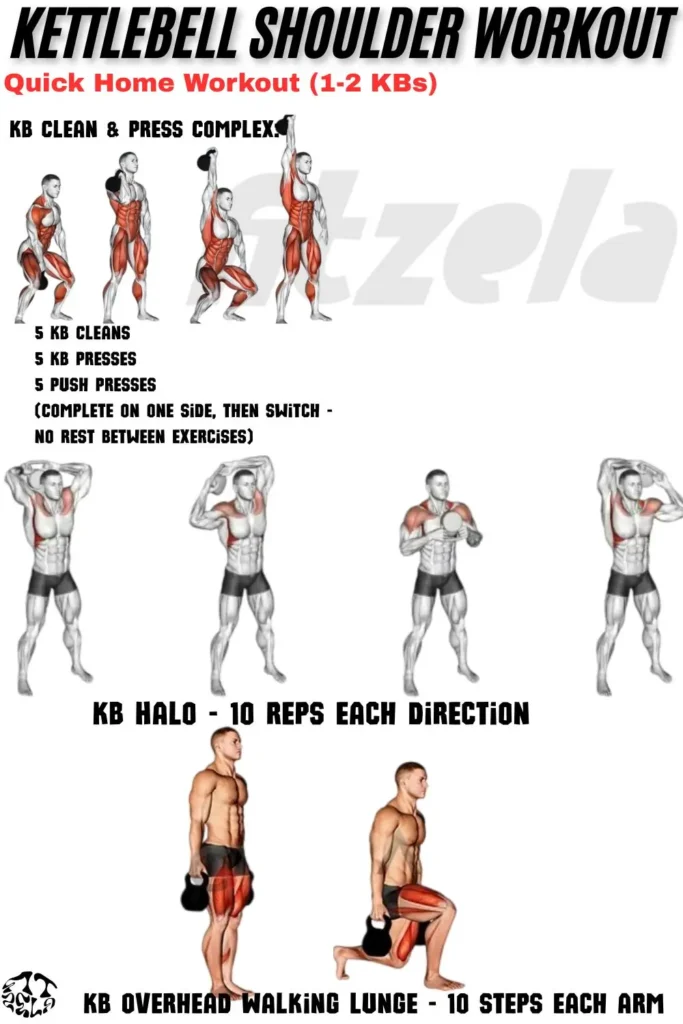
- KB Clean & Press Complex:
- 5 KB Cleans
- 5 KB Presses
- 5 Push Presses
- (Complete on one side, then switch – no rest between exercises)
- KB Halo – 10 reps each direction
- KB Overhead Walking Lunge – 10 steps each arm
Complete 3 rounds with 60 seconds rest between rounds. This efficient workout can be performed 2-3× weekly in under 20 minutes.
Avoiding Common Kettlebell Shoulder Training Mistakes
| Common Mistake | Problem | Solution |
| Flaring elbows during presses | Causes shoulder impingement | Keep elbows at ~45° angle from body |
| Poor rack position | Reduces power, stresses wrist | Keep bell close to forearm, wrist straight |
| Excessive back arching | Compensates for poor mobility | Engage core, maintain neutral spine |
| Shrugging during movements | Places stress on traps, not deltoids | Keep shoulders “packed” down and back |
| Neglecting rotator cuff work | Creates imbalances, injury risk | Incorporate halos, armbar, TGU |
| Starting too heavy | Compromises form and safety | Master technique with lighter weights first |
Progressing Your Kettlebell Shoulder Gains
To continue making progress with kettlebell shoulder training, implement these strategies:
- Increase weight – The most straightforward approach, though requiring investment in heavier kettlebells
- Increase volume – Add sets or reps before progressing to heavier weights
- Decrease rest periods – Create more metabolic stress for growth stimulus
- Improve technical mastery – Focus on perfect form, controlled negatives, and eliminating compensations
- Progress exercise complexity:
- Standard Press → Push Press → Bottoms-Up Press
- Floor Press → Bench Press → Strict Press
- Rack Carries → Overhead Carries → Uneven Load Carries
Remember: For shoulder development, perfect technique trumps heavy weight every time. Track your workouts to ensure progressive overload while maintaining form integrity.
Frequently Asked Questions (FAQ) about Kettlebell Shoulder Training
Can kettlebells build big shoulders? Absolutely! Kettlebells can build impressive shoulder size and strength, particularly when following structured progressive programs. The multiple angles of resistance and enhanced stabilizer recruitment can actually create more complete development than traditional methods alone.
Are kettlebells safe for shoulders? When used with proper technique, kettlebells are not only safe but can rehabilitate and strengthen shoulders. The natural arcing motion of many kettlebell exercises respects shoulder biomechanics, while the stabilization demands build resilient joints. Start light, focus on form, and progress gradually.
What’s the best kettlebell exercise for shoulders overall? If limited to just one exercise, the single-arm kettlebell press provides the most comprehensive shoulder development. It builds strength, size, and stability simultaneously while allowing natural movement patterns. The Turkish Get-Up is a close second for its exceptional shoulder stability benefits.
How heavy should my kettlebell be for shoulder presses? Most men should start with 16kg (35lbs) for pressing, while most women should begin with 8-12kg (18-26lbs). You should be able to maintain perfect form for 5+ strict reps. For bottoms-up variations, reduce weight by 30-50%.
What are kettlebell halo benefits for shoulders? Halos create exceptional mobility through the shoulder complex while simultaneously strengthening the rotator cuff in multiple planes of movement. Regular halo practice improves overhead positioning, reduces injury risk, and develops the small stabilizer muscles often neglected in traditional training.
Kettlebell vs. dumbbell for shoulder press? Each tool has its advantages. Kettlebells create more rotational challenge and grip demands while following more natural pressing arcs. Dumbbells allow for heavier loading and more standardized progression. For optimal development, incorporating both is beneficial, but kettlebells alone provide sufficient stimulus for most trainees.
Conclusion
Kettlebell training offers a unique and highly effective approach to shoulder development that builds strength, stability, and size simultaneously. The offset weight distribution and versatile movement patterns challenge your shoulders in ways conventional training simply cannot, resulting in more resilient and capable shoulders.
Remember that consistent practice with proper form is the foundation of success. Start with the appropriate kettlebell weight for your strength level, master the fundamental movements, and progressively challenge yourself through the sample routines outlined above.
Whether you’re training at home with limited equipment or seeking variety in your gym routine, incorporating these kettlebell shoulder workout principles will help you develop shoulders that not only look impressive but perform exceptionally well in sport and daily life.
Ready to transform your shoulder training? Select a routine that matches your experience level, grab your kettlebells, and begin building stronger, more stable, and better-looking shoulders today!
Have you tried kettlebell training for shoulders? Share your experience or questions in the comments below!


